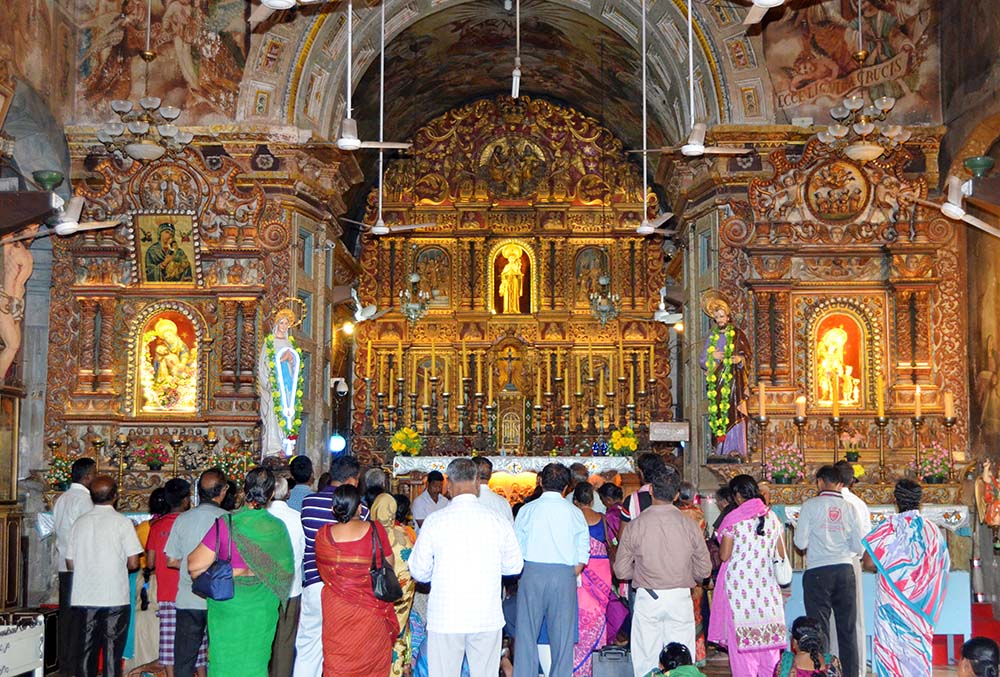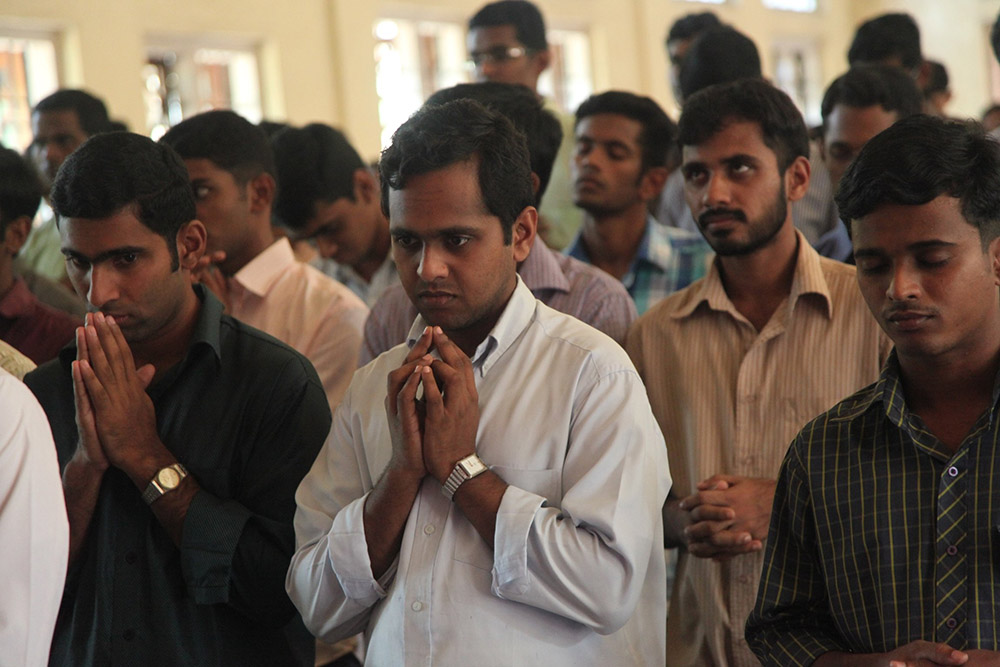
Worshipers at St. Antony's Syro-Malabar Catholic Forane Church in Ollur, Thrissur city in Kerala state, India (Wikimedia Commons/Mamichaelraj)
Over the last few weeks, the Catholic liturgical community has experienced significant papal intervention.
On July 6, the week prior to the moto proprio issuance of the controversial Traditionis Custodes, Pope Francis signed a letter to the major archbishop and bishops of the synod of the Syro-Malabar Church encouraging the synod's unanimous agreement in 1999 of uniformity in celebrating the Holy Qurbana, the Eucharist as celebrated in East Syriac Christianity.
The pope's letter includes a specific exhortation to the Syro-Malabar Church, echoing familiar themes of his pontificate: "I strongly urge the Syro-Malabar Bishops to persevere, and I confirm their ecclesial 'walking together' with God's people, trusting that 'time is greater than space' (cf. Evangelii Gaudium, 222-225) and that 'unity prevails over conflict' (cf. Ibid, 226-230)."
Francis follows this exhortation with a reinforced call to implement "the uniform mode of celebrating the Holy Qurbana, for the greater good and unity of your Church."
The 1999 synod of the Syro-Malabar Church
What led to the need for the 1999 synod's call for liturgical conformity in the Syro-Malabar Church?
Broadly speaking, there are three Catholic churches of different rites in India — Syro-Malabar, Syro-Malankara and the more traditionally known Latin church.
One faction within the Syro-Malabar Church favored the use of ad orientem in the liturgy — "to the east," with the presider's back to the congregation. This is consistent with the Chaldean Rite in which the Syro-Malabar tradition has deep roots.

Seminarians pray at St. Joseph Pontifical Seminary of the Syro-Malabar Catholic Church in India's Kerala state. (CNS/Courtesy of CNEWA/Msgr. John E. Kozar)
The opposing faction promoted the versus populum mode, consistent with the practice of the Latin Church following the Second Vatican Council. This group further expressed contention with the ad orientem faction since the former wanted an Indian liturgy distinct from the Chaldean Church.
The 1999 synod came to a compromise of having half the liturgy ad orientem and the other half versus populum.
Yet the versus populum faction was not satisfied with this, and continued in their preferred liturgical style.
Liturgy represents communion not only in terms of the reception of the Eucharist, but how members of the church relate to one another and to all of God's people. Divisions in the liturgy often reflect interpersonal disunity. As such, I believe Francis' reiteration of a unified liturgical practice, both in the Eastern and Western churches, includes a call to reflect on areas of disunity and "missing the mark" in the Catholic community, as well as an exhortation to work toward healing and conversion.
I believe God is calling the Syro-Malabar Church to "walk together" with God's people by reversing the following practices:
Clericalism
Indian culture, which is hierarchical and patriarchal in nature, is fertile ground to breed the sin of clericalism.
Priests, along with religious brothers and sisters, have social status among Indian Catholics that mirror clerical standing in the Middle Ages. Large Catholic families in India might send one or more children into the priesthood, brotherhood or sisterhood, and often this would allow these persons to obtain free education, room and board and potentially elevate the family's status.
Priests and religious are often hosted and given places of honor among middle- and upper-class Catholics, and since the church operates many schools and hospitals in India, there is relevance and status not only in the Catholic community but in the broader Indian society as well.
More specific to clericalism is the revelation of abuse and scandal among the clergy and religious, and the reaction from the local church to protect the abusers rather than the abused.
In March 1992, 19-year-old St. Joseph Sister Abhaya was discovered dead in a well adjacent to her convent in Kottayam, Kerala. The Kerala State Police initially dismissed this death as a suicide, but India's Central Bureau of Investigation (CBI) took the case on. In 2009, the CBI charged Fr. Thomas Kottoor and Sister Sefi with the murder of Sister Abhaya. Amid this, the local church asserted the innocence of the accused.
The case took 11 years to conclude. Verghese P. Thomas, who first investigated the case for the CBI, resigned due to pressure from senior officials to rule the case a suicide. However, in December 2020, the CBI Special Court concluded that both Kottoor and Sefi were guilty of the murder of Sister Abhaya, and issued them each a life sentence.
Activist Joman Puthanpurakkal, who singlehandedly took up this case to bring justice for the death of Sister Abhaya, disclosed that church authorities "shamelessly protected the murderers."
According to the CBI, Sister Abhaya discovered Kottoor and Sister Sefi, along with another priest, Fr. Jose Poothrukayil, engaged in sexual activity. The CBI reported that Abhaya had been attacked with an axe and dumped into the well.
Broken vows, murder, lies, cover-up and protection signify a multitude of problems in the Kottayam Diocese related to clericalism. A church that does not love and protect the vulnerable but chooses to support the predators does not reflect the Spirit of Christ, nor does this imitate Francis' call for the Syro-Malabar Church to walk together with God's people. Therefore, clericalism needs to be addressed and uprooted among the Syro-Malabar clergy and religious.
Casteism
The St. Thomas Christians trace their Christian roots to 52 A.D., and were rumored to originally be Brahmins, the highest of the Hindu castes. On the other hand, Portuguese missionaries brought lower caste fisher families into the Latin Church in the 1500s and beyond. Thus, Syro-Malabar Catholics have often enjoyed a higher social status in India's caste system.
Advertisement
In Privileged Minorities: Syrian Christianity, Gender, and Minority Rights in Post-Colonial India, Sonja Thomas explains that the "Syrian Christian community was rewarded by the landowning upper-class Hindus with land and caste privileges. Their privileged status is documented especially in the eighth-century Syrian Christian Copper Plates, which granted the community particular rights, including freedom from certain taxes, rights to trade, and land rights."
Casteism is incongruent with the Catholic faith. The catechism teaches that all persons are equal and created in the image and likeness of God, and therefore have dignity.
The Syro-Malabar Church cannot truly walk together with all of God's people without renouncing any and all caste privileges and supporting those who are among the lower caste.
Colorism
Indian culture values fair skin over dark skin. Syrian Christians generally have fairer skin relative to lower caste Indians. Colorism reinforces the status of Syrian Christians, including the members of the Syro-Malabar Church.
Similar with casteism, in order to walk together with all of God's people, Syro-Malabar Catholics need to recognize any internalized colorism, both in terms of judgment and benefits received, and renounce this vice in favor of solidarity with darker-skinned Indians. If not, the Syro-Malabar Church fails in its witness to Christ and in being a house of prayer for all people.
In Francis' recent address to the Syro-Malabar Church, he is calling this community to a comprehensive spirit of unity: to worship together consistently and to recognize the dignity of the other, regardless of caste or color.
Additionally, the pope exhorts the hierarchy to humbly walk together with God's people, renouncing the sin of clericalism and any means of placing themselves above the laity.
Lastly, the pontiff calls the Syro-Malabar Church to reverence the body of Christ received in Holy Qurbana by loving and receiving all members of the body of Christ, as well as accepting and defending all of God's people.




